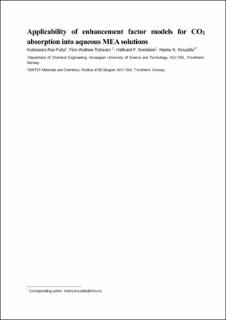| dc.contributor.author | Putta, Koteswara Rao | |
| dc.contributor.author | Tobiesen, Finn Andrew | |
| dc.contributor.author | Svendsen, Hallvard Fjøsne | |
| dc.contributor.author | Knuutila, Hanna K | |
| dc.date.accessioned | 2020-12-23T09:19:42Z | |
| dc.date.available | 2020-12-23T09:19:42Z | |
| dc.date.created | 2017-10-26T12:42:52Z | |
| dc.date.issued | 2017 | |
| dc.identifier.citation | Applied Energy. 2017, 206 765-783. | en_US |
| dc.identifier.issn | 0306-2619 | |
| dc.identifier.uri | https://hdl.handle.net/11250/2720880 | |
| dc.description.abstract | In many chemical industrial processes, mass transfer across gas-liquid interfaces accompanied by chemical reaction is the governing phenomena. In case of mass transfer accompanied by a chemical reaction in the liquid phase, the reaction will enhance mass transfer and generally the mass transfer enhancement is quantified in terms of an enhancement factor. Large number of enhancement factor models have been developed in literature and used without critical analysis for analyzing pilot data for CO2 absorption into aqueous amines. In order to perform such a critical analysis, 24 models are tested using lab-scale experimental data from four independent apparatuses for CO2 absorption into MEA solutions covering a range of different conditions such as short and long contact times, with and without gas phase resistance, high and low CO2 loadings and temperatures. Of the 24 enhancement factor models tested only six models were found to satisfactorily predict the experimental CO2 fluxes. These were the models based on the simple pseudo-first order reaction assumption, Emodels 1, 2 and 3 by Hatta [2] and Dankwerts [4] respectively, Emodel 20, the deCoursey and Thring [44] model based on Danckwert’s surface renewal theory with unequal diffusivities, Emodel 24, the recently published generalized model by Gaspar and Fosbøl [51] and Emodel 21, the Tufano et al. [67] model based surface renewal theory. All these models were found to work equally well to the discretized penetration model. No significant difference was found between Emodels 1, 2 and 3, indicating that whether one uses as basis a film, penetration or surface renewal model, is of insignificant importance. The success of the simple models is attributed to the short contact times in the experiments used as basis and the accuracy of the kinetic model. Contact times of the same magnitude between mixing points is also encountered in industrial packings and it is believed that the simple enhancement factor models may work well also in these cases if an accurate kinetic model is used. | en_US |
| dc.language.iso | eng | en_US |
| dc.publisher | Elsevier | en_US |
| dc.subject | Aqueous alkanolamines | en_US |
| dc.subject | CO2 absorption | en_US |
| dc.subject | Chemical reaction | en_US |
| dc.subject | Mass transfer | en_US |
| dc.subject | Enhancement factor model | en_US |
| dc.title | Applicability of enhancement factor models for CO2 absorption into aqueous MEA solutions | en_US |
| dc.title.alternative | Applicability of enhancement factor models for CO2 absorption into aqueous MEA solutions | en_US |
| dc.type | Peer reviewed | en_US |
| dc.type | Journal article | en_US |
| dc.description.version | submittedVersion | en_US |
| dc.rights.holder | This is a submitted manuscript of an article published by Elsevier Ltd in Applied Energy, 8 September 2017. | en_US |
| dc.source.pagenumber | 765-783 | en_US |
| dc.source.volume | 206 | en_US |
| dc.source.journal | Applied Energy | en_US |
| dc.identifier.doi | 10.1016/j.apenergy.2017.08.173 | |
| dc.identifier.cristin | 1507982 | |
| cristin.unitcode | 7401,80,0,0 | |
| cristin.unitname | SINTEF Materialer og kjemi | |
| cristin.ispublished | true | |
| cristin.fulltext | preprint | |
| cristin.qualitycode | 1 | |
